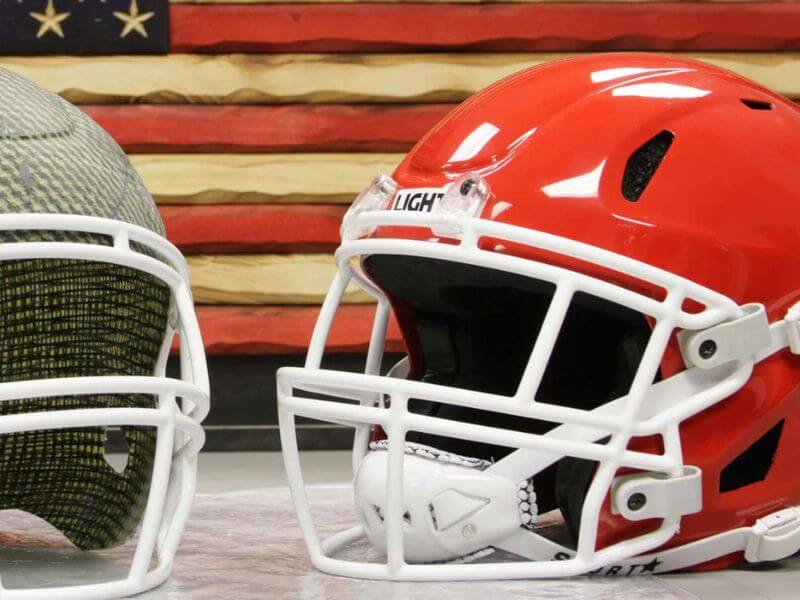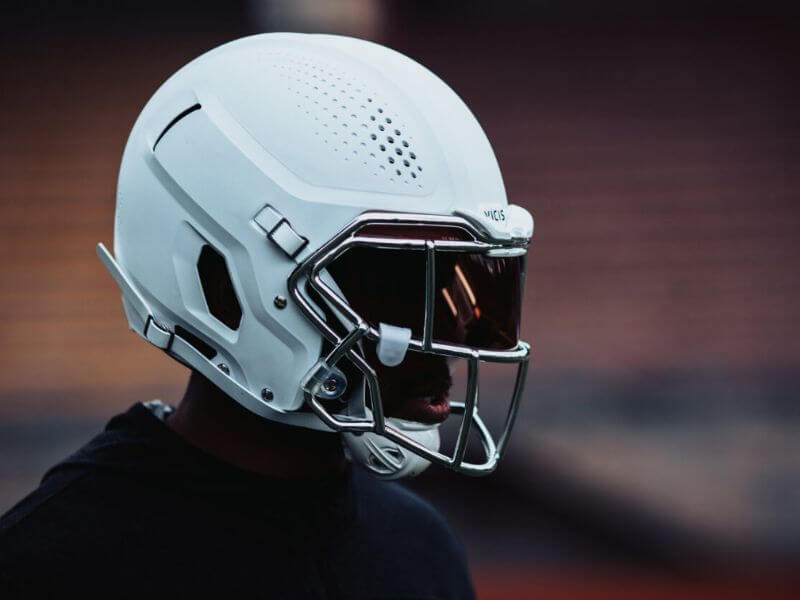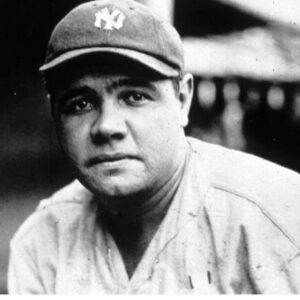What are football helmets made of ? As you’re getting ready for this year’s Super Bowl, you may be stocking up on mini hotdogs, inviting your friends over to watch the game, and making sure your team jersey is ready to go. While you do that, professional football players are busy practicing, running plays — and making sure their equipment is safe.
From the tops of their heads to the bottoms of their cleats, football players need a range of safety equipment to protect themselves during the game. You may be very familiar with one piece of football gear, but you might not realize how much it has changed in the last 100 years: the helmet.
Improvements in Football Helmets Over the Years
Over the years, better football helmets have made the game and the players safer. You may be surprised to know how many times the football helmet has been improved — or that they weren’t even mandatory in the NFL until 1943.
What you know of as a football helmet now, didn’t always look like that. In the early 1900s, players wore helmets made out of soft leather, the same material shoes were often made out of. Like you might guess, these helmets did not offer the players much protection.
Football helmets have come a long way since these first leather helmets, going from leather to plastic, and changing from being open-faced to having face bars and masks. It wasn’t until the 1960s and 70s that helmets started having foam padding in them.
Today, football helmets are made out of multiple layers that protect the player from head injuries like a concussion. Football helmets typically have a layer of leather closest to the skin, which is then covered with foam, then aluminum, and finally an outside shell of polycarbonate.
While the helmets football players wear today are vastly different from the ones players wore when football started taking off, there is still a long way to go — and companies are continuing to make them even safer.
Helmets are becoming even more customizable, and, with 3D printing, they are being designed for individual players. Leading football helmet makers Riddell and Carbon have since announced their collaboration in producing 3D-printed football helmet liners.
These helmet liners are custom-built for a specific player. They use measurements of a player’s head shape and size when it’s being made, allowing the helmet to better absorb force from a blow upon impact.

How Better Helmets Protect Players
Football is a sport that involves a lot of contact, which can lead to a lot of injuries. The improvement to football helmets over the years has aimed to address the number of concussions that occur during games and practices.
In 2021, there were 187 concussions in the NFL during preseason and regular season games and practices. (The number of concussions has gone down over the years, but there are also fewer games and practices than there used to be.)
Concussions are serious injuries that can produce long-term health effects. A fall, sports injury, car accident, assault, or other direct injuries to the skull can cause a concussion. But concussions don’t only happen to professional athletes — they can occur to any individual playing tackle football, along with other sports.
“Concussions are injuries that many people consider to be just another part of the football experience, but they’re not to be ignored,” says Jennifer Del Rossi, MPT, Concussion Specialist at Chester County Hospital. “If you or someone you know has experienced a fall or blow to the head, it’s better to be on the safe side, and see a provider immediately. Concussions that go untreated — as well as repeat head injuries — can lead to lasting brain damage or immediate health issues.”
EVOLUTION OF FOOTBALL HELMETS
Every Sunday during football season the excitement and anticipation build as we wait for kickoff. Through sprains, twists, and breaks, it’s no doubt that all of the NFL teams leave it all on the field, playing their hardest every play, every game, and every season.
Although it may seem that all too many injuries are reported year after year, the evolution of the football helmet has come a long way since its introduction to the field, and so too have the way athletes and committee members view the seriousness of head injuries. NFL reporting showed a 24 percent decrease in concussions during the preseason and regular season, from 281 in 2017 to 214 in the 2018 season. The drop was particularly noteworthy in the regular season when the number of diagnosed concussions went from 190 in 2017 to 135 in 2018 — a 29 percent decrease.
Football helmets are the only thing protecting player’s heads from hard hits, concussions, and other head injuries during a game. A football helmet can be defined as a piece of protective equipment used mainly in American football and Canadian football. It consists of a hard plastic shell with thick padding on the inside, a face mask made of one or more plastic-coated metal bars, and a chinstrap.
However, when football helmets were first invented, this wasn’t the case.
THE FIRST FOOTBALL HELMET
The first use of football headgear dates back to 1869 when George “Rose” Barclay, the Lafayette College halfback, started to use straps and earpieces to protect his ears. There is no documentation on who actually invented the football helmet. However, some sources credit James Naismith, while others credit U.S. Naval Academy Midshipman, Joseph M. Reeves, who had a protective headpiece made out of moleskin in the 1893 Army-Navy game.
THE INITIAL ADOPTION OF FOOTBALL HELMETS
Helmets were widely used in football during the 1920s. These helmets consisted of leather with some padding on the inside but provided little protection. While the helmet was developed to protect the head, these helmets lacked face mask and as a result, injuries were still common.
It wasn’t until 1939 when the first plastic helmet became available. The Riddell Company of Chicago manufactured the first plastic helmet, believing it was safer than the leather options that were being used on the field. The plastic frame was able to hold its shape when collision occurred and included more padding and cushion for safety. The plastic helmet also included a plastic face mask, protecting the entire head.
THE EVOLUTION OF FOOTBALL HELMETS IN THE NFL
In the mid-1940s, leather helmets were required in the NFL. It wasn’t until 1949 that the NFL officially adopted the plastic helmet, ending the leather helmet era. By the mid-50’s, single face bars were added to the helmets, and the first appearance of the radio helmet was introduced.
Through the 60’s, and 70’s, Riddell continued to innovate and improve the football helmet protection and design. By the 1980s, Riddell had become an icon with its classic helmet silhouette with a circular earhole, clean face mask lines, and rounded dome.
In 2002, in response to the study of head injuries, Riddell developed a new helmet designed called the Revolution. The revolution was the first significant remodel in 25 years, and as of 2007, Riddell has sold 750,000 helmets. In 2007, due to the demand for a safer football helmet, Schutt Sports announced the arrival of a next-generation helmet, the Schutt ION 4D.

TODAY’S FOOTBALL HELMET & ENHANCING PROTECTION
Today, NFL athletes are allowed to choose their own helmets for any particular reason. It can be for protection, nostalgia, or purely aesthetic. However, all helmets have to be approved by the National Operating Committee on Standard for Athletic Equipment (NOCSAE).
While the standard and protection of football helmets have come a long way since its inception, players who prioritize their safety often look for ways to add an additional layer of support. Technology has progressed in a way that enables companies like 2nd Skull to help empower athletes by adding additional protection to the most critical part of the human body.
Our newly launched 2nd Skull Pro Cap was designed in collaboration with a grant and support from the NFL, made with extreme impact protection material. The light-weight, breathable design offers additional protection without adding bulk or discomfort under a helmet.
You don’t have to be a pro to add an additional layer of protection under your football helmet.
Above is information what are football helmets made of. Hopefully, through the above content, you have a more detailed understanding of what are football helmets made of .Thank you for reading our post.









